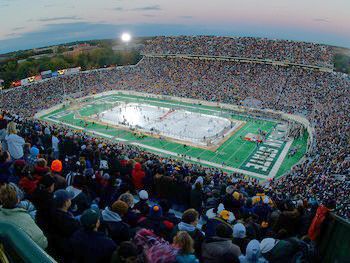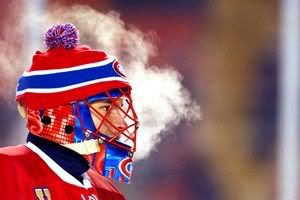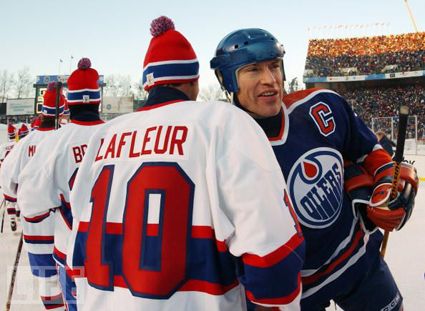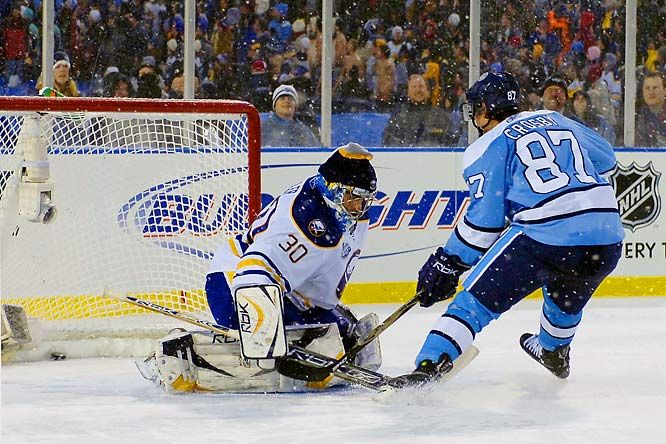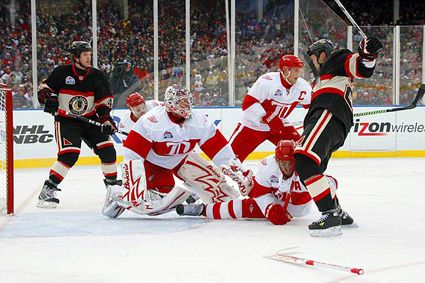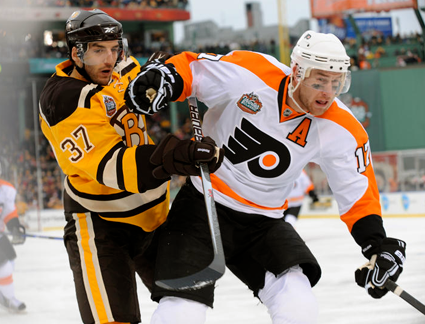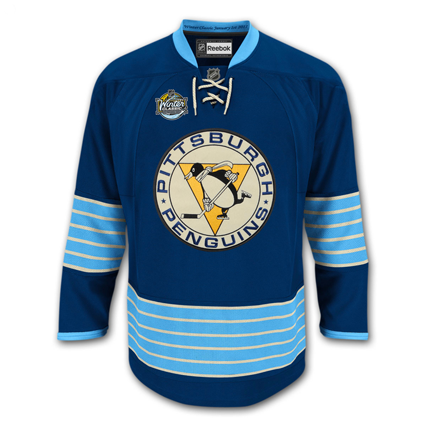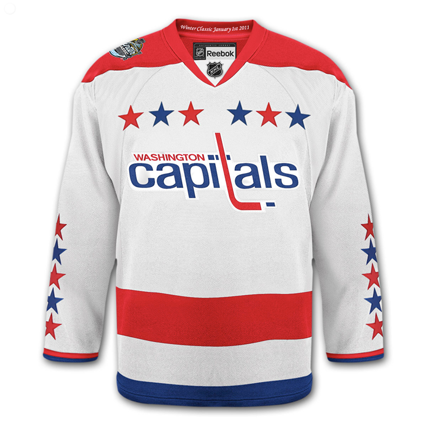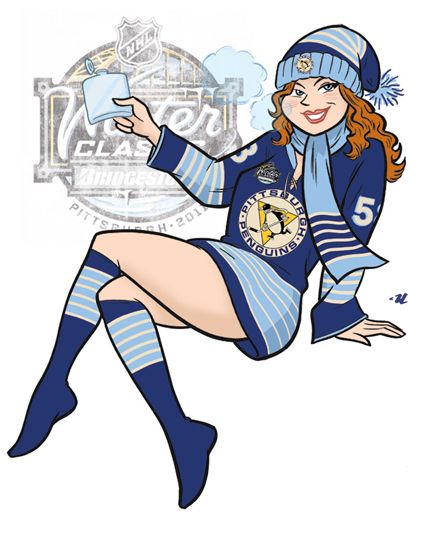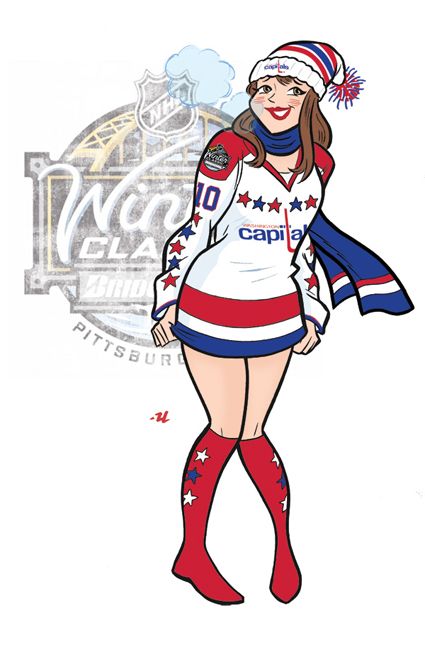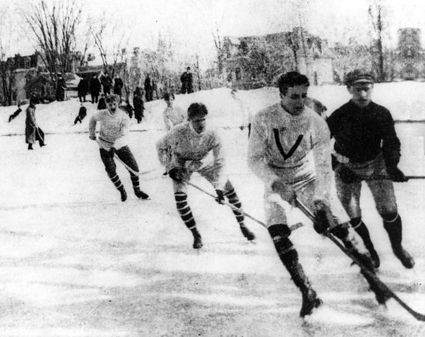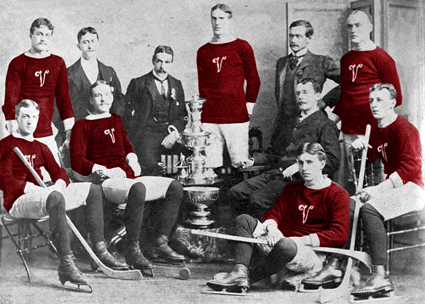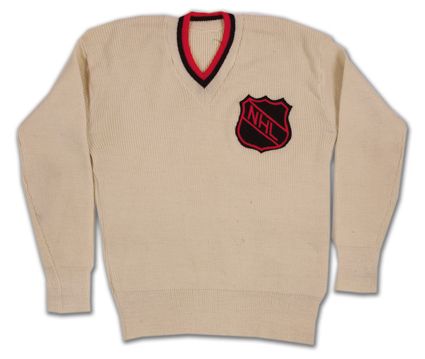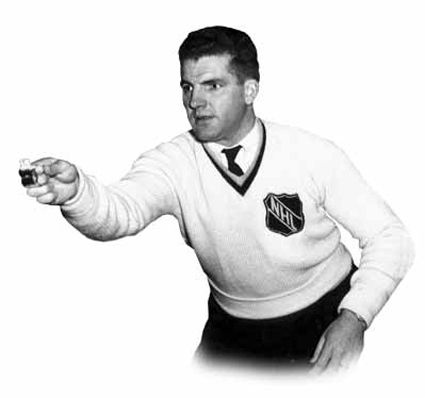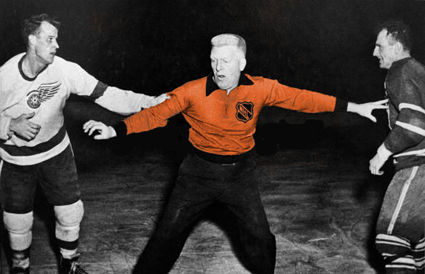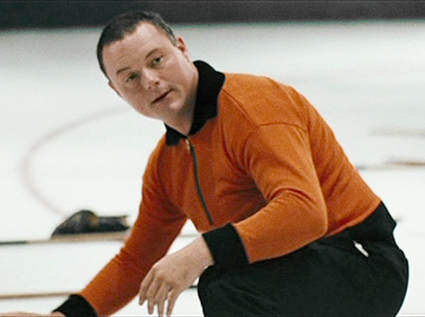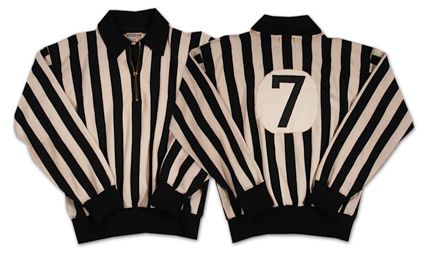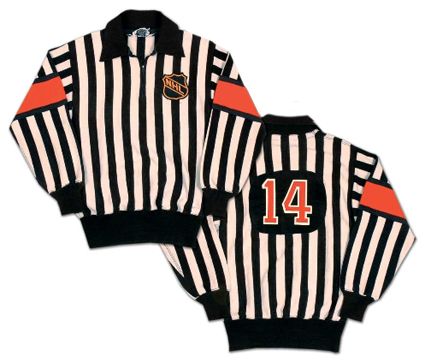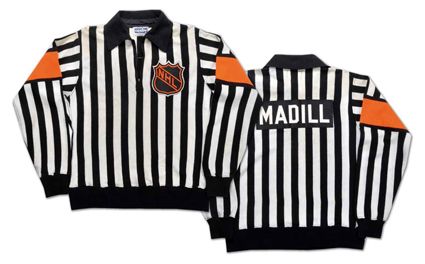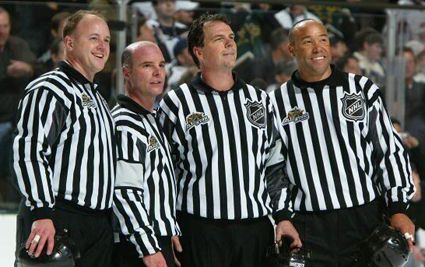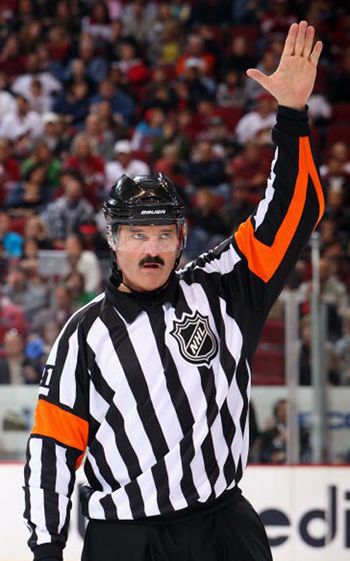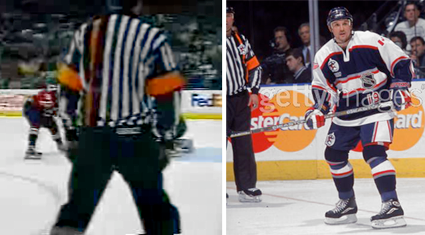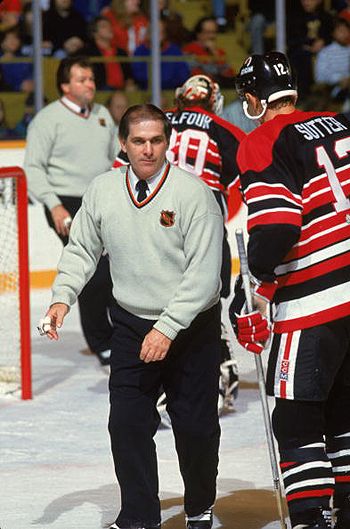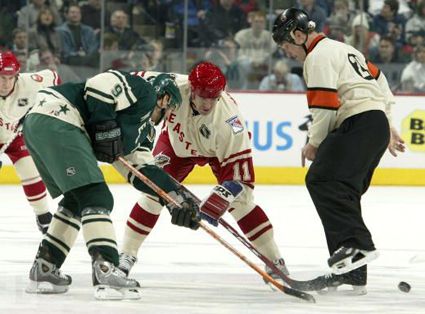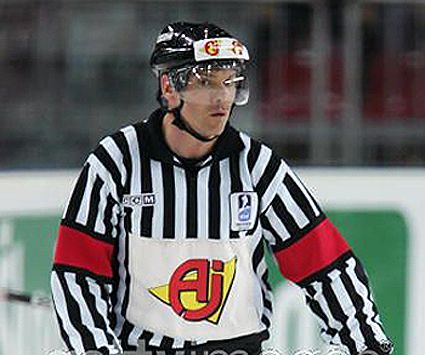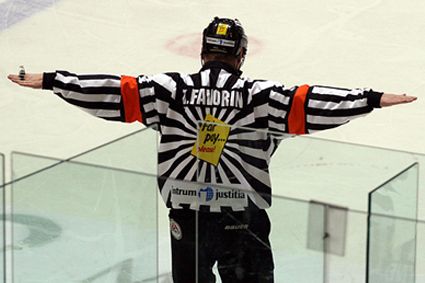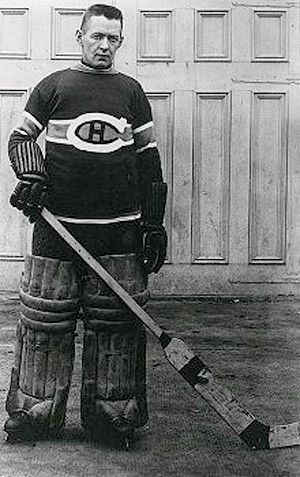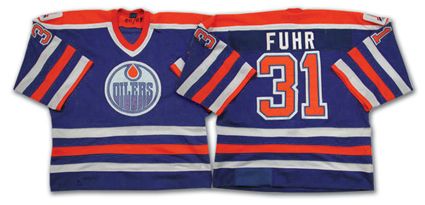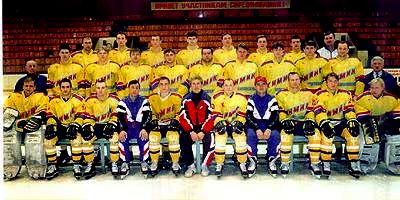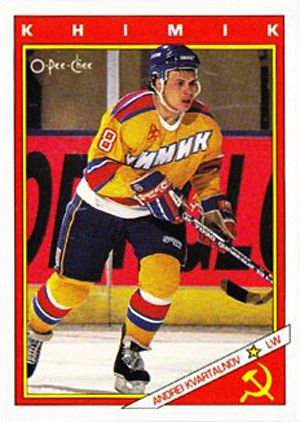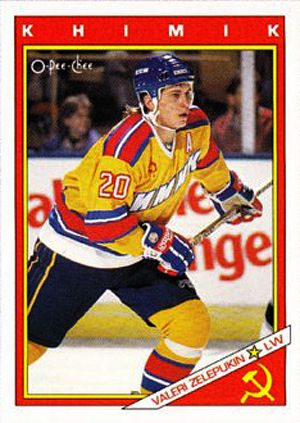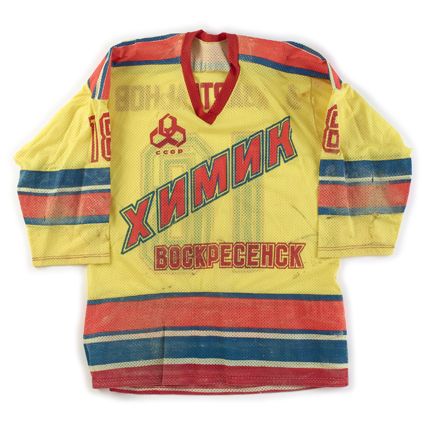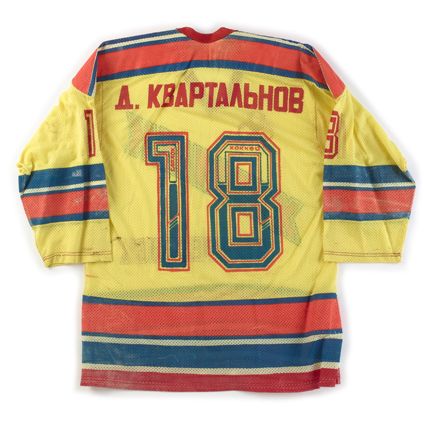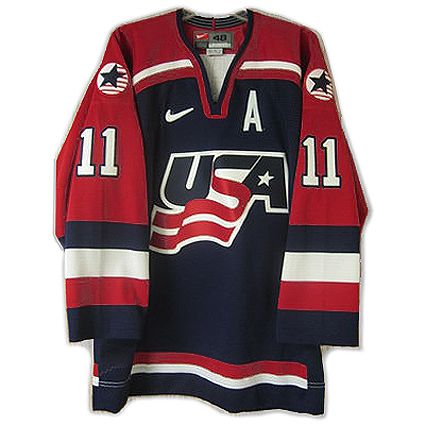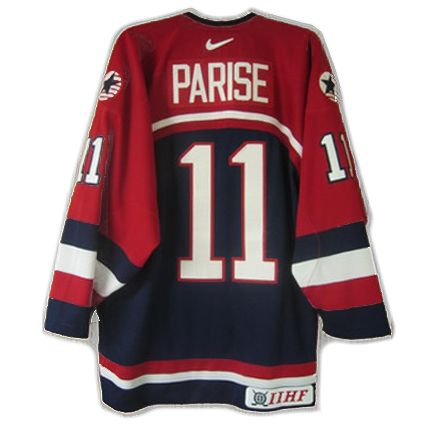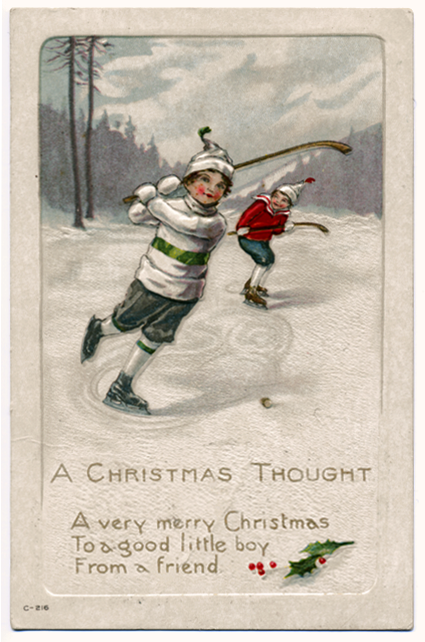Friday, December 31, 2010
2007-08 Pittsburgh Penguins Sidney Crosby Jersey
The NHL's 4th annual Winter Classic takes place tomorrow, Saturday, January 1st, at Pittsburgh's Heinz Field, home of the NFL's Steelers.
The original inspiration for the Winter Classic must be given to The Cold War, an outdoor game held at Spartan Stadium in East Lansing, Michigan when Michigan State University and the University of Michigan of the CCHA battled to a 3-3 tie in front of 74,544 fans, an attendance figure which no doubt raised eyebrows with the powers that be across the NHL.
The Cold War
The first to to embrace the concept in the NHL was the Edmonton Oilers, who hosted the Montreal Canadiens on November 22, 2003 at Commonwealth Stadium, home of the CFL's Edmonton Eskimos.
Jose Theodore wearing a toque during the Heritage Classic
In addition to the game itself, which counted in the NHL's regular season standings, the event drew a great deal of publicity for the MegaStars Game, an exhibition game between Oilers legends from their 1980's dynasty versus a team of Canadiens legends from their dynasty of the 1970's. To date, that event is the one and only time Wayne Gretzky has taken part in an NHL old-timers game of any kind, and something he has publicly stated will be the only time. Such was the importance of the event in Canada, that Mark Messier received special permission from the New York Rangers to take part in the game despite being the only player still active in the NHL.
Mark Messier congratulates Guy Lafleur following the MegaStars game
The Winter Classic began in 2008 when the Pittsburgh Penguins faced off against the host Buffalo Sabres at Ralph Wilson Stadium, primary home of the Buffalo Bills of the NFL. The game was a tremendous success on many levels, as 71,217 fans set an NHL attendance record, the weather cooperated with a picturesque snowfall during the game and the most visible player in the league, Sidney Crosby, scored the game winning goal in the shootout for Pittsburgh.
One other element of the game was an outstanding success, the use of throwback jerseys by both the Penguins and Sabres. The Penguins revived their powder blue road jerseys from the 1970-71 season while the Sabres opted for their original home white jerseys from the same 1970-71 season.
The Sabres jerseys were very well received as the club was presently wearing their controversial "Buffaslug" jerseys at the time as fans longed for a full-time return to the team's original look. An updated version of their classic blue jersey was the first result, being introduced the following season and became the team's primary jersey two seasons later.
The Penguins, fueled by the popularity of stars Evgeni Malkin, and especially that of Crosby, adopted the 2008 Winter Classic jersey as their alternate jersey the following season and sold them by the thousands.
The use of throwback jerseys at the Winter Classic has remained, with the Chicago Blackhawks hybrid style of a 1935-36 jersey mated with a 1948 logo taking on the Detroit Red Wings, who employed the jerseys originally worn by the Detroit Cougars in the franchise's first season of 1926-27. The Blackhawks jerseys continue to live on, with the addition of a secondary logo on the shoulders as the club's third jersey.
The 2009 Winter Classic at Wrigley Field
In 2010, the Philadelphia Flyers, whose jerseys haven't changed all that much since their inception, stripped away many of the modern additions to their jerseys and reverted to a simpler style based on their 1970's jerseys with the revival of the use of a nameplate of a contrasting color to the jersey, which is based on the Flyers only having one set of white nameplates made up in the days when teams had to add names to their jerseys for national TV games. This jersey was a white version of their current orange third jersey, and when it was promoted to the primary jersey for 2010, the white Winter Classic jersey was revived as the Flyers new road jersey.
The Boston Bruins also went the hybrid route in 2010 and created a striking jersey that used the 1958-59 jersey template done in the brown and gold colors the Bruins wore during their first decade mated with the crest from their first use of the famed spoked "B" logo in 1948. Additionally, the crest and numbers were done in a retro felt material, which only enhanced the retro effect that much more.
The 2010 Winter Classic held at Fenway Park
For 2010, both the host Penguins and the Washington Capitals have announced their retro jerseys. The Penguins have gone back to their inaugural season for inspiration by using their first jersey's original template and unique number font, but with the navy and light blue colors reversed. They then decorated it with a an original and unused version of their skating penguin logo, a thinner penguin wearing a winter scarf.
The Capitals have also returned to their roots, reviving their original star spangled red, white and blue jerseys used from 1974 until 1995.
In anticipation of the 2011 Winter Classic, artist and Penguins fan Robert Ullman has created a pair of his hockey pin-up girl illustrations featuring the Penguins and Capitals Winter Classic jerseys. These illustrations are available as signed 9" x 12" prints for $16 each, as well as sticker versions for $2.50. If you act now, his 20% off holiday sale is still in effect if you enter the coupon code "Holiday10" when you check out.
Today's featured jersey is a 2008 Pittsburgh Penguins Sidney Crosby jersey as worn during the first NHL Winter Classic in 2008. This jersey was a copy of the Penguins 1970-71 jerseys and proved to be an enormous hit with the fans , no doubt aided by the fact superstar Crosby not only wore it, but scored the game winning goal while the snow was falling in Buffalo, creating a truly memorable moment that ensured that the Winter Classic would become an annual event.
This jersey was brought back the following season as the Penguins alternate jersey and has remained popular with the fans and a strong seller.
In the weeks leading up to the 2011 Winter Classic, HBO has been following both the Penguins and Capitals and documenting every aspect of the team's respective triumphs and struggles, as he Penguins were on a roll during captain Crosby's ongoing scoring streak as the losses kept mounting for the Capitals.
Today's video section, and your homework assignment for the day, features both the first, second and third hour long episodes of 24/7 Penguins/Capitals: Road to the Winter Classic. While the first episode has been edited for language, the second and third ones have not and are not f***ing safe for work or youngsters, as the f***ing coach of the f***ing Capitals, Bruce f***ing Boudreau f***ing let's his team f***ing have it in an attempt to f***ing motivate them in the second episode and the f***ing coarse language continues in the f***ing third episode as well when f***ing Crosby and f***ing Ovechkin show the f***ing intensity of what f***ing beating the other f***ing means to them.
Episode 1 - Suitable for all ages
Episode 2 - Rated R for f***ing language
Episode 3 - Rated R for a bit more of the same f***ing type of language
Labels:
Crosby Sidney,
Pittsburgh Penguins
Thursday, December 30, 2010
1896-97 Montreal Victorias Ernie McLea Jersey
When the Dominion Hockey Challenge Cup was donated by Lord Stanley of Preston as an award for Canada's best amateur team in 1892, it was on a challenge basis, meaning more than one club could have the rights to hold the cup during a given year.
The first holders of the cup were the Montreal Hockey Club (also known as Montreal AAA, which stood for Amateur Athletic Association), who won the rights to the cup as champions of their league, the Amateur Hockey Association of Canada. In 1894, four clubs tied for the best record in the league and following a series of playoff games to break the tie, the Montreal Hockey Club repeated as champions.
The Montreal Victorias won the AHAC championship in 1895 but were not originally awarded the cup, as the trustees of the cup has already accepted a challenge for the cup, still held by the Montreal Hockey Club, from Queen's University of Kingston, Ontario.
Graham Drinkwater of the Montreal Victorias in 1895
The trustees of the Stanley Cup, in a most unusual decision, decided that if Montreal AAA defeated Queen's University to defend the supremacy of the AHAC, the Victoria's, champions of the league that Montreal AAA belonged to, would be awarded the cup! The Montreal Hockey Club did win 5-1 and the Montreal Victorias became holders of the Stanley Cup for 1895.
The AHAC champion Victorias were challenged by the Winnipeg Victorias of the Manitoba Hockey League during the Montreal Victorias AHAC season on February 14, 1896. The Winnipeg Victorias came away victorious in the battle of Victorias by a score of 2-0, led by goalie Whitey Merritt, the first goalie to ever wear leg pads.
Two weeks later the Winnipeg Victorias locked up the MHL season title to retain ownership of the cup and were immediately challenged by the Montreal Victorias when their regular season concluded with them repeating AHAC champions in early March.
The only problem was that no suitable ice could be found with spring now on hand and the Montreal Victorias challenge, while accepted by the trustees, was postponed until the following winter. When cold weather again arrived, before the start of the 1896-97 season, the Montreal Victorias challenge of the Winnipeg Victorias was scheduled on this date in 1896 to be played at the Granite Rink in Winnipeg.
It was described at the time as the greatest sporting event in Winnipeg history, with fans paying as much as $12 for a seat while fans back in Montreal gathered for up to the minute reports via telegraph.
Things went well for the home team as Winnipeg led at halftime by a score of 4-2. Montreal fought back, and while Winnipeg was able to score again, the team from the east was able to tie the game at 5-5 before the 20 year old Ernie McLea, who had already scored twice for Montreal and with time winding down, fired his third goal of the game past Winnipeg goaltender Merritt to win the game in the closing seconds to regain the cup for the Montreal Victorias in what was called "the finest match ever played in Canada" when it was all over.
McLea's three goals were the first hat trick in Stanley Cup history.
The AHAC champions and Stanley Cup holders, the Montreal Victorias.
Note the diminutive size of the Stanley Cup during it's formative years when compared to the AHAC championship trophy towering above it.
Graham Drinkwater and Mike Grant from the 1986 Stanley Cup champion Victorias would eventually be inducted into the Hockey Hall of Fame, both in 1950.
The Montreal Victorias would go on to win the 1897 AHAC title that season to retain the Stanley Cup and then turn back the challenge of the Ottawa Capitals in December of 1897. After once again repeating as league champions in 1898, with McLea scoring four goals in seven league games, they would once more defeat the Winnipeg Victorias in a two-game, total-goal series by a score of 5-3 in February of 1899.
The Victorias would finally relinquish the Stanley Cup after three years and 21 days when the Montreal Shamrocks won the Canadian Amateur Hockey League championship, a new league the Montreal Victorias were now members of. The Victorias finished the season with a 6-2 record, one game behind the Shamrocks 7-1 mark with their only two losses coming at the hands of the Shamrocks.
The Victorias would never again hold the Stanley Cup, but would remain active as an amateur club as the divide between amateurs and professionals widened during the early part of the twentieth century. The Victorias would win the Allan Cup twice, once in 1908 and again in 1928 before ceasing operations in 1939.
Today's featured jersey is a 1896-97 Montreal Victorias Ernie McLea jersey. McLea became the first man to ever score a hat trick in a Stanley Cup game on this date in 1896. He joined the Victorias in 1896 for two games, scoring one goal and then appeared in two more Stanley Cup games, which included his noteworthy hat trick, the first ever in a Stanley Cup game.
Over the next three seasons, McLea scored eight in eight games in 1897, four more in seven games in 1898 and four goals in four games in 1899. He played one final game for the Victorias in 1900 and finished his five year career with 17 goals in 22 games played.
The Victorias represented the Scottish population of Montreal and wore burgundy sweaters with a "V" logo in various fonts during their early days. Like many clubs in the late 1800's the Victorias were named after Queen Victoria of England.
Labels:
McLea Ernie,
Montreal Victorias
Wednesday, December 29, 2010
1992-93 NHL Referee Andy Van Hellemond Jersey
Prior to wearing the familiar black and white striped jerseys, NHL referees wore cream colored sweaters, as well as neckties, which made for a quite dapper look. The cream sweaters lasted into the early 1950's.
1940's NHL referee's sweater
Hockey Hall of Famer and first American referee Bill Chadwick wearing a cream colored referees sweater, complete with necktie
Following the cream colored sweaters, in order to differentiate themselves from the home player's white sweaters, NHL referees changed in March of 1953 to a bright orange style with a half zip front, which sadly meant neckties were no longer worn.
Referee Red Dunn tries to maintain order between
Gordie Howe and Ted Kennedy in the early 1950's
Gordie Howe and Ted Kennedy in the early 1950's
An orange referee's sweater from the 2005 film "The Rocket: The Legend of Maurice Richard"
Finally on this date in 1955, NHL on-ice officials wore brand new vertically striped black and white sweaters for the first time ever during a game between the Montreal Canadiens and the Toronto Maple Leafs, which was won by Montreal 5-2.
1950's NHL referee's sweater
At some point the referees began wearing orange arm bands to differentiate themselves from the linesmen, and today's NHL sweaters have remained essentially unchanged since then.
1960's NHL referee's sweater, now displaying orange armbands
While the NHL referees' sweaters had now reached what would essentially be their final look, the World Hockey Association, which arrived on the scene in 1972, did so with a splash, outfitting their officials in bold, if not gaudy, red and white striped sweaters, which featured not only the officials number on the back, but their name as well.
1970's WHA referee's sweater
Sometime around 1977, NHL referees began to wear their names on their backs instead of the traditional numbers.
1980's NHL referee's sweater with the referee's name on the back rather than the traditional numbers
The use of names on the back lasted until a return to the use of numbers once again for the 1994-95 season. NHL rules stipulate that referees have to wear numbers between 2 and 49, while linsemen can choose numbers from 50 to 98, with #1 and #99 not being permitted.
2000's NHL referee's sweater
There has been some tinkering of the referee's sweaters as of late, with black undersides to the sleeves, as well as an ill-fated attempt to change the orange armbands to silver for the 2007-08 season in an attempt to tie in with the new silver and black colors of the new NHL shield. With the silver armbands proving essentially invisible, this idea thankfully died a quick and quiet death.
See if you can spot the silver referee's arm stripes
The latest tweak to the sweaters arrived at the 2009 NHL All-Star Game, when new fabrics and additional black trim were added to the sweaters, as well as extending the orange arm bands down the length of the bottom of the arms, which are visible when the referee's arm is fully raised. These sweaters were adopted full time and have been in use starting with the 2009-10 season.
2009 NHL referee's sweater
At times officials have worn patches on their jerseys, such as the league-wide patches for the Stanley Cup Centennial, as is the case with today's featured jersey. There have also been instances of referees wearing memorial patches as well. In the 1989-90 season, officials wore the initials "J. McC." on their sweaters to memorialize John McCauley, the director of NHL officiating who passed away in June 1989. In 2005-06 NHL officials wore a #72 patch in memory of linseman Stephane Provost who passed away in May 2005 due to a motorcycle accident.
Another notable referee's jersey was worn during the 2000 NHL All-Star Game in Toronto, when the teams wore futuristic jerseys inspired by the millennium, which carried over to the referee's jerseys. They featured a vertical orange stripe down the left side of the jersey, both front and back, with the 2000 All-Star Game patch centered over the stripe on the right chest.
The cream colored sweaters were revived during the 1991-92 NHL season whenever two of the Original 6 teams played against each other while wearing their Turn Back the Clock jerseys, as well as that season's NHL All-Star Game, when both teams wore throwback jerseys in recognition of the NHL's 75th anniversary.
Ray Scampinello wearing a 1991-92 NHL throwback referee sweater
The cream throwback sweaters were also put back into service during the first NHL outdoor event, 2003's Heritage Classic when the Montreal Canadiens legends took on a team of Edmonton Oilers legends, with both teams wearing throwback jerseys and the officials once more got into the spirit of the event with turn back the clock sweaters of their own.
2003 Heritage Classic referee Andy Van Hellemond
The next outing for the cream colored throwbacks was an appearance at the 2004 NHL All-Star Game in St. Paul, Minnesota when the referee's joined in with the players throwback jersey look, only this time with the All-Star Game patch on the upper right chest but without the need for the toques!
Unlike the clean look of referee's sweaters in the NHL, the referee's sweaters in european hockey are viewed as prime real estate for advertisements, such as the sponsorship worn by referee's at the IIHF World Championships in the 2000's.
Referee at the IIHF World Championships with sponsorship on his sweater
Not even the traditional vertical stripes of the referee's sweaters are considered sacred in european leagues!
European league referee with an unorthodox striping pattern
Today's featured jersey is a 1992-93 NHL referee Andy Van Hellemond sweater. This sweater was worn during the era of referees wearing their names on the backs of their sweaters. This jersey also features the Stanley Cup Centennial patch as worn on not only all the players jerseys in 1992-93, but also the referees' sweaters.
Van Hellemond began officiating NHL games in 1969 and continued to do so until his retirement in 1996, a span of 28 years, which included 19 Stanley Cup Finals. He became the first on-ice official to wear a helmet in 1984, something which became mandatory in 2006-07.
Van Hellemond was the director of NHL officiating from 2000 to 2004 and was inducted into the Hockey Hall of Fame in 1999.
Our video section today pays tribute to referee's and linsemen and the risky job it can be on the ice with the array of sticks, pucks, skates and even fists they must try to avoid, sometimes unsuccessfully.
Several NHL referees and linesmen have written books about their careers from their unique point of view. To purchase one of them, please click on the links below.
Labels:
Referee's Jerseys
Tuesday, December 28, 2010
1988-89 Edmonton Oilers Grant Fuhr Jersey
On this date in 1918, Georges Vezina of the Montreal Canadiens became the first goalie in NHL history to be awarded an assist when Newsy Lalonde gathered up the puck after a save by Vezina, skated the length of the ice and scored a goal during a 6-3 Canadiens win over the Toronto Arenas.
Georges Vezina
It would take 61 years before a goaltender would be credited with scoring a goal, and he never actually shot the puck. That occurred on November 28, 1979 when Rob Ramage of the hapless Colorado Rockies gathered up the puck after a save by the New York Islanders Billy Smith during a delayed penalty call and passed the puck back out of the corner, which unfortunately for the Rockies sailed by his intended teammates and had enough force to continue all the way down the length of the ice and into the Rockies unmanned goal.
It would take eight more years for an NHL goalie to genuinely shoot the puck into the opposing net when Ron Hextall of the Philadelphia Flyers score against the Boston Bruins on December 8, 1987. Hextall later scored again during the playoffs against the Washington Capitals on April 11, 1989.
Martin Brodeur of the New Jersey Devils is the only other goalie to date to have scored twice with a playoff goal in 1997 and a regular season goal in 2000.
Jeff Reese holds the record for most points by a goaltender in a game with three, which he scored on February 10, 1983 while playing for the Calgary Flames.
It should come as little surprise to find out that an Edmonton Oiler holds the record for most points by a goaltender in a season, as well as the career record for most points by a goalie. Those honors belong to Grant Fuhr of the high powered Oilers. His record of 14 points in 1983-84 set the standard which still remains the one to beat more than 25 years later.
While Fuhr certainly earned a number of assists by simply going behind the net and teeing up a dump-in for Paul Coffey to carry up the ice and set up a Wayne Gretzky goal, Fuhr also earned a number of assists by firing the puck up the ice to an open teammate to initiate a rush.
Fuhr career total of 60 points (which includes regular season and playoffs combined) leads all goalies in career scoring, followed by Patrick Roy's 56, who just barely tops the 55 scored by Tom Barasso. Brodeur ranks fourth all time with 44 points, two of which were goals. Mike Vernon's 41 leads both Hextall and John Vanbiesbrouck at 38, with two of Hextall's points coming from his goals.
The rest of the top ten consist of Ed Belfour at 35, Curtis Joseph's 33 and the tenth spot is occupied by both Sean Burke and Dan Bouchard, who are tied at 30. Honorable mention goes to Kirk McLean (29), Andy Moog (28), Bill Ranford (26) and the duo of Mike Palmateer and Tony Esposito with 25 each. Of the 16 goalies listed, only Broduer remains active.
Today's featured jersey is a 1988-89 Edmonton Oilers Grant Fuhr jersey. Fuhr remains the all-time point scoring leader among NHL goalies with 60, four more than the next closest pursuer, and holder of the most points in a season by a goaltender for over 25 years.
Fuhr played 19 NHL seasons and won 403 games with the Oilers, Buffalo Sabres, Toronto Maple Leafs, Los Angeles Kings, St. Louis Blues and Calgary Flames as well as being the Oilers starting goaltender for Stanley Cup championships with the Oilers in 1984, 1985, 1987 and 1988. He also won the Canada Cup in both 1984 and 1987. He also won the Vezina Trophy in 1988 and was inducted into the Hockey Hall of Fame in 2003. Just to be clear, the Vezina Trophy is awarded for puck stopping ability, not goalie scoring exploits!
Here is footage of Broduer's first goal, which came in the 1997 playoffs.
Our final video today is a tribute to Grant Fuhr and a collection of some of his flashiest saves.
Dasherboard: The World Junior Championships had a light schedule yesterday. Slovakia won in 2-1 overtime in their game against the plucky Germans to pull even with the United States with two points in the Group A standings, one point behind Switzerland.
In Group B, the Czech Republic did what was require by shutting out Norway, but the 2-0 score does little to inspire anyone into believing the Czechs will be strong enough to advance to the Playoff Round in light of Sweden's 7-1 drubbing of Norway the day before.
Today's schedule is a full four games, with Switzerland and Finland battling it out in Group A. With three points for a win in international hockey, a win for Switzerland would all but guarantee them a place in the Playoff Round. The day's second game has the Czech Republic hoping to stifle Canada's scoring attack and come away with at least a point or two in the standings. A win for Canada, even if it comes in overtime, will put them in an excellent position to advance with Norway still on their schedule and a likely three points from that game.
Sweden will be facing Russia at Dwyer Arena in the best matchup the smaller rink will see all tournament. A regulation win for Sweden will certainly put the Russians in a bad spot while a win for the Russians keeps them right in the mix in the "Group of Death".
The final game of the day has the United States looking to improve upon their performance in their opening game which went to overtime. A regulation win could very well see them at the top of the group by the end of the day and in a good position to earn one of the coveted byes directly into the semifinals.
Labels:
Edmonton Oilers,
Fuhr Grant,
Vezina Georges
Monday, December 27, 2010
1989-90 Khimik Voskresenek Dimitri Kvartalnov Jersey
The hockey club Khimik Voskresensk was formed in Voskresensk 55 miles southeast of Moscow in the Soviet Union and played their first game on this date in 1953, with "Khimik" meaning "Chemists" in deference to the local chemical plant which sponsored the club.
It took the club just three years to rise to the top level of Soviet ice hockey. They won bronze medals in the Soviet League playoffs in 1965 and 1970. Starting in the mid-1980's the club entered the period of it's greatest success with a third bronze medal in 1984 prior to achieving their best ever result of a silver in 1989, which they immediately followed with another bronze in 1990.
Also in 1990, Khimik Voskresensk was chosen as one of four clubs to compete in the Super Series, a schedule of exhibition games against NHL teams played in North America, a fine reward for their recent run of good play. Khimik fared fairly well, beating Los Angeles 6-3, lost to Edmonton and Calgary 6-2 and 6-3, rebounded to down Detroit 4-2 but then lost to Washington 5-2. They concluded their trip with a 6-3 win over St. Louis to finish with a 3-3 record.
Khimik Voskresensk
They returned in 1991 with very similar results, losing to Los Angeles 5-1 and St. Louis 4-2 before a tie with the New York Islanders 2-2. They then strung together three consecutive wins over Montreal 6-3, Buffalo 5-4 and Boston 5-2 before a loss to Minnesota 6-4 once more left them with a .500 record at 3-3-1.
Changes in the way the club was run on the business side began to occur in the late 1990's due to the collapse of the Soviet Union, which led to the club losing it's sponsorship when the chemical plant found a new owner, as well as the departure of it's better players to not only the NHL, but the leagues in Germany, Finland and Sweden. Eventually the club first altered it's name from Khimik Voskresensk to Khimik Moscow Oblast, with "Oblast" being the equivalent to a province, in an effort to represent the entire region around Moscow, which was quite an ambitious claim seeing how the Moscow Oblast was already home to Central Red Army, Dynamo, Spartak, Wings and Lokomotiv at the time.
In 2005 the club relocated to Mytishchi, 60 miles northwest of Voskresensk and changed their name to Atlant Moscow Oblast in 2008 in time for the formation of the Kontinental Hockey League, bringing to an end the club's use of the Khimik name for good after 46 seasons of play.
Following the team's relocation away from Voskresensk, a new expansion team called HC Khimik Voskresensk was formed, but has no connection to the original club and it's history.
During their history, Khimik produced many recognizable names, particularly in more recent times as they players came over to North America to compete in the NHL. Dimitri Kvartalnov won the Soviet League scoring title while playing for Khimik in 1990 prior to playing for the Boston Bruins.
Dimitri Kvartalnov, incorrectly identified as his brother Andrei
Germain Titov played 624 NHL games primarily with the Calgary Flames, Slava Kozlov played 1,182 games in the NHL and won two Stanley Cups with the Detroit Red Wings, Sergei Berezin logged more than 500 games, first with the Toronto Maple Leafs, Andrei Lomakin was one of the early Soviet players to make the move to North America, while Valeri Zelepukin and Sergei Brylin both won the Stanley Cup with the New Jersey Devils in 1995.
Valeri Zelepukin
Current Montreal Canadien Andrei Markov began his professional career with Khimik, as did Stanley Cup winner Valeri Kamensky, but the best known player to have come out of the Khimik must be Igor Larionov, who led Khimik in scoring in 1981 and eventually went on to win two gold medals in the Olympics, four in the World Championships, one in the Canada Cup and three Stanley Cups with the Red Wings.
Today's featured jersey is a 1989-90 Khimik Voskresenek Dimitry Kvartalnov jersey as worn by Kvartalnov when he was the leading scorer in the Soviet League. It's typical of the Soviet jerseys of the era in that it is a relatively light weight mesh and all the graphic elements are either dye sublimated or screened on. Of note are the wild numbers on the back. This jersey also has Dimitri's first initial "D" on the back in cyrillic, as his brother Andrei was also a member of the team.
Dasherboard: In the 2011 World Juniors, Switzerland roared out to a 4-0 lead by the end of the first period only to have the determined Germans get back to within one with 4:41 to play, but Switzerland held on to take the three points in Group A.
Also in Group A, the United States got the win in overtime on a goal by Nick Bjugstad. The win in overtime was worth two points, with Finland earning one.
In Group B, Canada scored three third period goals to pull away from Russia, who played Canada even through the first two periods before falling 6-3. In the other group game, Sweden trounced Norway 7-1.
Labels:
Khimik Voskresenek,
Kvartalnov Dimitri
Sunday, December 26, 2010
2004 Team USA Zach Parise Jersey
Today kicks off the IIHF 2011 World Junior Hockey Championships in Buffalo, New York where the 2010 champions from the United States will be looking to defend their title on home ice.
The World Juniors have become a much anticipated annual event, particularly in Canada, and anybody who's anybody has played in the tournament on their road to the NHL, dating back to Wayne Gretzky, Jari Kurri, Mario Lemeiux, Steve Yzerman, Alexander Mogilny, Sergei Fedorov, Jeremy Roenick, Mike Modano, Pavel Bure, Jaromir Jagr and Peter Forsberg through current NHL stars Jarome Iginla, Daniel and Henrik Sedin, Zach Parise, Ryan Getzlaf, Alexander Oveckin, Evgeni Malkin, Sidney Crosby, Johnathan Toews and Patrick Kane, making it a must-see event each year.
The ten teams in this year's edition are divided into two groups of five and each team will play the other four teams in it's group once each in the Preliminary Round, with the top three advancing to the Playoff Round. With so few games determining each team's fate, no one can afford to take a night off as each and every game is critical to each team's chances.
For the unfortunate four clubs who finish in the bottom two of their groups, they will be placed in the Relegation Round. Following a round-robin schedule among the four, the bottom two teams of the group will be demoted to the Division I level for 2012 and will need to earn their way back up to the Top Division, which can only be achieved by winning a championship in Division I. Second place earns you nothing but another season at the Division I level. This relegation format ensures that nearly every game matters in the World Juniors and the games that determine which clubs stay up can be very exciting affairs when two countries are battling with survival on the line. We strongly encourage those in attendance take in the final day of the relegation round if the placings have not already been determined at that point. Spirited games in the much more homey secondary arena can provide some terrific competition in a small town or collegiate atmosphere that differs greatly from the environment more polished main rink and is a recommended part of the World Junior Tournament experience.
Once in the Playoff Round, the two group winners will receive a bye directly into the semifinals as a reward, while the second place team in Group A will face the third place team in Group B and vice-versa, with those two quarterfinal games taking place on January 2nd.
The two quarterfinal winners advance to face the group winners, who will enjoy the advantage of two days of rest, in the semi finals on January 3rd. The semifinal losers will meet for the bronze medal on January 5th with the winners meeting for the gold medal later that evening.
Thanks to some unexpected results in recent tournaments, the usual even distribution of familiar hockey powers in each group has been thrown out the window for 2011. Group A consists of the United States, Switzerland, who finished a strong fourth in 2010, Finland, Slovakia and recently promoted Germany.
Group B on the other hand, has been declared "The Group of Death" and is stacked with Canada, Sweden, Russia, who were classified a disappointing 6th in 2010, the Czech Republic, who shockingly found themselves in the Relegation Round in 2010, and underdogs Norway.
In Group A, the Americans are favored to advance and will be looking to earn one of the coveted byes into the semifinals. Finland and Switzerland are also expected to advance to the Playoff Round and must avoid giving away points, or worse, being upset by either Slovakia or Germany. The Slovaks goal will be to avoid the relegation round, and to do so, must upset one of the favored three teams and steal a point by getting to overtime against one of the other two.
Germany's goal for 2011 will be to maintain their place in the Top Division by surviving the Relegation Round. Their game against Slovakia on December 27th will be a key opportunity to gain points towards that end should Slovakia be the other team placed in the Relegation Round, as the game between the two teams from each group that are placed in the Relegation Round will carry over to the Relegation Round standings.
Group B is obviously a lot more complicated, as annual championship contenders Canada, Sweden, who have strongly re-emerged from a down period with three consecutive medal placings, Russia, who will not want a repeat of last year's disappointing placing following five consecutive finishes in the medals, and the Czech Republic, will all slug it out for the bye awarded to the group winner, with one of those four guaranteed a place in the fight to avoid relegation.
Poor Norway will be in for a rough go and will most certainly be hoping one of the four teams ranked above them will be having a down year and that they can take some points out of the game against the club that will join them in the relegation round for a shot at unlikely survival.
Canada put together a dominant run of five consecutive titles from 2005 to 2009, but their program is a victim of it's own success in breeding top quality players, as tournament eligible players Matt Duchene and Ryan O'Reilly (Colorado), Tyler Seguin (Boston), Jeff Skinner (Carolina), Evander Kane (Atlanta), Taylor Hall (Edmonton) and Kyle Clifford (Los Angeles) will not take part due to having found gainful employment in the NHL. Still, 16 of the 22 Canadian players are already first round draft picks in the NHL. Once again, similar to 2005 when the United States hosted the tournament in Grand Forks, North Dakota, the proximity of the tournament to Canada, this time less than four miles from the Canadian border, should ensure the Canadians will feel right at home playing in front of tens of thousands of red-clad supporters waving the Maple Leaf each time they take to the ice.
The host United States has eight players returning from the team that won gold in overtime to break Canada's streak last year. Goaltender Jack Campbell, defenseman John Ramage and forwards Ryan Bourque, Jerry D'Amigo, Chris Kreider, Jeremy Morin, Kyle Palmieri and Jason Zucker all are back in an attempt to capture a second consecutive gold, this time on home ice.
The tournament begins with four games today, with Germany taking on Switzerland in the opening game at 12:30 PM (all times eastern) in the first of three games at the 18,000 seat HSBC Arena in Buffalo.
The NHL Network in the United States will be replaying last year's gold medal game between the United States and Canada at 2 PM (following replays of the USA's 2010 quarterfinal and semifinal games) as a prelude to their airing of the all-important second game on the schedule between Canada and Russia at 4 PM, also in Buffalo. The game will be carried in Canada by TSN.
Also starting at 4 PM, Norway opens against Sweden at the 2,100 seat Dwyer Arena on the Niagara University campus and the day is capped off by the United States beginning it's championship defense with a stiff challenge from Finland, which will be televised by the NHL Network in the US and on TSN2 in Canada at 6 PM.
Fans in attendance in Buffalo will have the luxury of being able to attend any game they choose since the two arenas are located just 16 miles apart, unlike some other years when the two host arenas have been several hours drive between them. With the large number of games compressed into such a small schedule, the second arena can often find itself hosting some terrific matchups, such as Sweden vs. Russia on December 28th and the Czech Republic vs. Russia on December 31st in a more personal atmosphere than the professional sized main rink has to offer. We highly recommend taking in one game at the secondary arena during the Preliminary Round each year when possible.
In the United States, the NHL Network will be airing all four of the Preliminary Round games for both the United States and Canada, as well as the game on Thursday between Sweden and the Czech Republic at 3 PM. With each game for the US and Canada of the preliminary round being aired, it means each team in the tournament will be on TV at least once.
Once the Playoff Round begins, all six games on January 2nd, 3rd and 5th will be aired through the gold medal final.
For viewers in Canada, the four Canadian Preliminary Round games, as well as the US vs. Finland on December 26th (8 PM - TSN 2), Sweden vs. Russia on December 28th (7 PM), both Sweden vs. the Czech Republic (3 PM) and Germany vs. the United States (7 PM) on December 30th and the United States vs. Switzerland on December 31st (8 PM) will be aired prior to their coverage of the six Playoff Round contests.
In a nice bit of traditional scheduling, the tournament always takes off New Year's Day between the Preliminary Round and the commencement of the playoffs, avoiding any conflict with the now annual NHL Winter Classic, which just also happens to take place less than four hours drive down the freeway in Pittsburgh for the more ambitious (and financially well off) ones in attendance in Buffalo.
Today's featured jersey is a 2004 United States National Team Zach Parise jersey from the first American team to ever capture a gold medal at the World Junior Tournament, which took place in Helsinki, Finland. The United States won their group by defeating Austria, Slovakia, Sweden and Russia before defeating Finland and then Canada in the final to claim the championship.
Parise led the US with five goals and 11 points on his way to being named the Most Valuable Player of the tournament.
This style of jersey was first used by the United States at the 2002 Olympics in Salt Lake City and remained in use through the 2005 World Junior Tournament.
Here are extended highlights from the 2004 World Juniors when the United States captured the gold medal thanks to an errant clearing attempt by Canadian goaltender Marc-Andre Fleury.
This next highlight is the gold medal winning goal in overtime by American John Carlson from last year's World Juniors, the second title for this year's hosts the United States.
Labels:
Parise Zach,
USA,
World Junior Championships
Saturday, December 25, 2010
Merry Hockey Christmas! Joyeux Hockey Noël!
We hope Santa was good to you this year and brought you the jersey you've been wanting!
We also hope you enjoy our special video collection today.
Don't forget - as our countdown clock in the right hand column shows - tomorrow the World Junior tournament begins, the annual festival hockey featuring "Tomorrow's Stars Today"!
And now...
On to the videos!
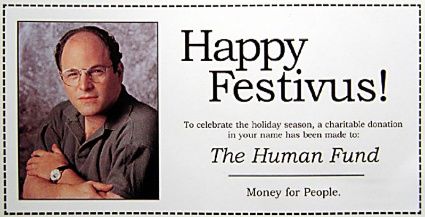
Again, Merry Christmas and Happy Holidays, and for those of you who do not celebrate Christmas, Happy Festivus!

Labels:
humor
Subscribe to:
Comments (Atom)

